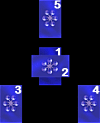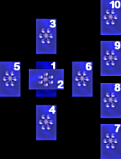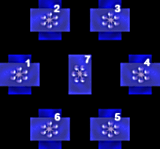Tarot Spreads
 The Tarot is consulted by performing readings, which may be general in nature or may address a specific question or area
of the querent's life. The simplest form of reading is the selection and interpretation of a single card (see our free weekly readings
for an example of this), but a greater number of cards is usually
employed to allow a fuller exploration of the subject. Interpreting the
cards according to their basic meanings and associations alone is a
rather disjointed and unsatisfying approach. For this reason, the cards are selected and arranged
according to a predetermined pattern called a spread, in which each card is interpreted not only with respect to its innate meaning,
but also according to its position in the spread.
The Tarot is consulted by performing readings, which may be general in nature or may address a specific question or area
of the querent's life. The simplest form of reading is the selection and interpretation of a single card (see our free weekly readings
for an example of this), but a greater number of cards is usually
employed to allow a fuller exploration of the subject. Interpreting the
cards according to their basic meanings and associations alone is a
rather disjointed and unsatisfying approach. For this reason, the cards are selected and arranged
according to a predetermined pattern called a spread, in which each card is interpreted not only with respect to its innate meaning,
but also according to its position in the spread.
 Spreads offer many more refinements to interpretation than positional
considerations alone. For example, each card can be related to other
cards in the reading to clarify particular points and bring an
additional richness to the interpretation. In some spreads, certain
positions have strong links with others, and cards in these
corresponding positions are interpreted with reference to each other.
Spreads allow the use of techniques like synthesis, majorities,
dignities, resonance, dissonance and combinations. All of this is
covered in Interpreting a Tarot Reading.
Spreads offer many more refinements to interpretation than positional
considerations alone. For example, each card can be related to other
cards in the reading to clarify particular points and bring an
additional richness to the interpretation. In some spreads, certain
positions have strong links with others, and cards in these
corresponding positions are interpreted with reference to each other.
Spreads allow the use of techniques like synthesis, majorities,
dignities, resonance, dissonance and combinations. All of this is
covered in Interpreting a Tarot Reading.
There are many spreads, from the simple to the confusingly complex,
but all strive to provide a framework on which the meanings of the
cards involved can be placed and worked into an insightful whole. Each
spread is designed for a particular type of reading. Some are
well-suited to general readings where no particular question is being
asked, others work best when a specific question is being explored, and
others are geared towards gauging the time scales involved in a
reading. A variety of spread examples is given below. Click on a spread
for more details.
Other articles of interest:
|
History of the Tarot
|
A history of the Tarot from its appearance in medieval Europe through to today's proliferation of decks.
|
 |
|
Jung and the Tarot
|
An introduction to the ideas of psychiatrist Carl Gustav Jung that relate to study of the Tarot, including archetypes,
the collective unconscious and the four functions of the mind.
|
 |
|







 The Tarot is consulted by performing
The Tarot is consulted by performing  Spreads offer many more refinements to interpretation than positional
considerations alone. For example, each card can be related to other
cards in the reading to clarify particular points and bring an
additional richness to the interpretation. In some spreads, certain
positions have strong links with others, and cards in these
corresponding positions are interpreted with reference to each other.
Spreads allow the use of techniques like synthesis, majorities,
dignities, resonance, dissonance and combinations. All of this is
covered in
Spreads offer many more refinements to interpretation than positional
considerations alone. For example, each card can be related to other
cards in the reading to clarify particular points and bring an
additional richness to the interpretation. In some spreads, certain
positions have strong links with others, and cards in these
corresponding positions are interpreted with reference to each other.
Spreads allow the use of techniques like synthesis, majorities,
dignities, resonance, dissonance and combinations. All of this is
covered in 


